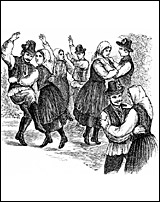 |
Dance


Hungarian dance is a set of Hungarian folkloric dances.
According to György Martin, a prominent folklore expert, Hungarian dances can be divided into two categories.
The first refers to dances performed in the middle ages while the second relates to the 18th and 19th century.
Improvisation is often mentioned as being characteristic of Hungarian dance.
"The peasant dance is not one which is set absolutely according to rule; the dancer constructs his steps according to his mood and ingenuity."
The most important stylistic feature of the dance within the Carpathians is the unusually large amount of personal improvisation.
Observers have never failed to notice the individual nature of the Hungarian dance during the previous two centuries.
This dancing is individual to such an extent that it is often difficult for scholars to establish the communal laws regulating individual creativity and improvising.
Folk dance research has shown that this individuality is not merely poetic licence, but genuine features.
Daniel Berzsenyi wrote, "Its secret laws are not ordered by craft.
The laws are its own and enthusiasm sets the limit."
Folkdance display in Szegvár during the Ace-festival:
A hundred couples are moving,
all of them together,
There will be an infinite labyrinth,
An interwoven abundance
Unseizable medley
In which-as many as there are couples-as many
Shapes and moods of the dance,
And yet it is the same beat
That governs everyone's steps."
"...Steps, turns, movement, postures, all are arbitrary, left to the taste and genius of the dancer.
The dance does not consist of regular well-defined steps ...
but an individual dance inspired by an idea." "the men free their partners when, and for so long as, they fell inclined.
Thus their hands are free and they can again take hold of their partner when they wish..."
"The brisker movements of the dance retained that peculiarity which is the feature of all Hungarian dances: the right of the dancer to improvise according to his talent and mood." Collections of the Folk Music Research Group of the Hungarian Academy of Sciences, and the national Ethnographic Museum of the State Folk Ensemble cover almost 10,000 dance variations from 700 Hungarian villages.
Hungarians have been noted for their "exceptionally well developed sense of rhythm".
Billroth performed tests with troops stationed in Vienna and found that the Hungarian troops outperformed others in keeping time with music.
A poem published in about 1670, and probably written by a Calvinist preacher, recorded that the Hungarian dancer bends his trunk, "shakes his head and inclines his neck, tilts his hat over one ear, kicks like a tired horse, sticks his chest out, makes his eyes sparkle, opens his mouth now to shout "hejje! hujja!", jumps about, stamps out the rhythm, slides, swings his legs energetically, etc." The poem was titled "A knotty stick for the purpose of straightening the backs of those striplings who in form resemble men but in dancing and capering are like goats and kids, and for describing their offensiveness when prancing".
The Csárdás is undoubtedly the most popular and important dance in the Hungarian repertoire.
In the 1869 book The Magyars: Their Country and Institutions Arthur Patterson wrote the following.
"they whirl swiftly round, two or three times, and then, breaking away, recommence the pantomime as before...
One seldom sees two couples performing exactly the same figure at the same time.
While two separated partners are doing their step with their backs turned on one another, another couple between them is spinning round in the ecstasies of reunion." Also featured are varied ways of holding a partner, complex changes of posture, slight crouching (lippetos), and lifting the woman in a jump and throwing her away."
Figures danced during the Swift Csárdás include the lippentos-martogatos (crouching-dunking), turning in pairs, and playful alluring and releasing of the partner.
Half crouching, half turning figures were still being danced by the older generation in the 1970s.
In a rare form of the Broom Dance the broom is put through a crouching, tripping movement (at Jaszszentandras).
Half crouching, half turning figures were still being danced by the older generation in the 1970s.

Folk dances
- Ugrós (Jumping dances): Old style dances dating back to the Middle Ages.
Solo or couple dances accompanied by old style music, shepherd and other solo man's dances from Transylvania, and marching dances along with remnants of medieval weapon dances belong in this group.
- Karikázó: a circle dance performed by women only accompanied by singing of folksongs.
- Csárdás: New style dances developed in the 18th and 19th centuries is the Hungarian name for the national dances, with Hungarian embroidered costumes and energetic music.
From the men's intricate bootslapping dances to the ancient women's circle dances, Csárdás demonstrates the infectious exuberance of the Hungarian folk dancing still celebrated in the villages.
- Verbunkos: a solo man's dance evolved from the recruiting performances of the Austro-Hungarian army.
- The Legényes: is a men's solo dance done by the ethnic Hungarian people living in the Kalotaszeg region of Transylvania.
Although usually danced by young men, it can be also danced by older men.
The dance is performed freestyle usually by one dancer at a time in front of the band.
Women participate in the dance by standing in lines to the side and sing/shout verses while the men dance.
Each lad does a number of points (dance phrases) typically 4 to 8 without repetition.
Each point consists of 4 parts, each lasting 4 counts.
The first part is usually the same for everyone (there are only a few variations).
SOURCE: Wikipedia
|
 |